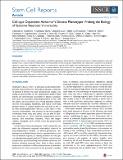Cell-type Dependent Alzheimer's Disease Phenotypes: Probing the Biology of Selective Neuronal Vulnerability
Author(s)
Muratore, Christina R.; Zhou, Constance; Liao, Meichen; Fernandez, Marty A.; Taylor, Walter M.; Lagomarsino, Valentina N.; Pearse, Richard V. II; Rice, Heather C.; Negri, Joseph M.; He, Amy; Srikanth, Priya; Callahan, Dana G.; Shin, Taehwan; Zhou, Monica; Bennett, David A.; Noggle, Scott; Love, J. Christopher; Selkoe, Dennis J.; Young-Pearse, Tracy L.; ... Show more Show less
DownloadPublished version (4.104Mb)
Terms of use
Metadata
Show full item recordAbstract
Authors Alzheimer's disease (AD) induces memory and cognitive impairment in the absence of motor and sensory deficits during its early and middle course. A major unresolved question is the basis for this selective neuronal vulnerability. Aβ which plays a central role in AD pathogenesis, is generated throughout the brain, yet some regions outside of the limbic and cerebral cortices are relatively spared from Aβ plaque deposition and synapse loss. Here, we examine neurons derived from iPSCs of patients harboring an amyloid precursor protein mutation to quantify AD-relevant phenotypes following directed differentiation to rostral fates of the brain (vulnerable) and caudal fates (relatively spared) in AD. We find that both the generation of Aβ and the responsiveness of TAU to Aβ are affected by neuronal cell type, with rostral neurons being more sensitive than caudal neurons. Thus, cell-autonomous factors may in part dictate the pattern of selective regional vulnerability in human neurons in AD. In this article, Muratore et al. examine differential vulnerability of neuronal subtypes in AD by directing iPSC lines from control and familial AD subjects to different regional neuronal fates. APP processing and TAU proteostasis are differentially affected between regional fates, such that neuronal cell type dictates generation of and responsiveness to Aβ.
Date issued
2017-11Department
Massachusetts Institute of Technology. Department of Chemical Engineering; Koch Institute for Integrative Cancer Research at MITJournal
Stem Cell Reports
Publisher
Elsevier BV
Citation
Muratore, Christina R., et al. “Cell-Type Dependent Alzheimer’s Disease Phenotypes: Probing the Biology of Selective Neuronal Vulnerability.” Stem Cell Reports, 9, 6 (December 2017): 1868–84. © 2017 The Authors
Version: Final published version
ISSN
2213-6711